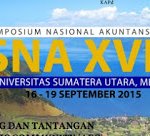[wpfilebase tag=file id=17]
Analisis Pendekatan Nilai Wajar dan Nilai Historis Dalam Penilaian Aset Biologis Pada Perusahaan Agrikultur: Tinjauan Kritis
Rencana Adopsi IAS 41
Saur Maruli dan Aria Farah Mita
Universitas Indonesia
[Jurnal Akuntansi Keuangan dan Pasar Modal (SNA 13)]
Abstract
This study discusses about the analysis of application of fair value and historical cost approaches used by agricultural companies in valuing their biological assets. The term of biological assets in this study refers to the biological assets possessed by agricultural companies specifically plantation companies. Due to IFRS convergence process done by IAI to adopt IAS 41, this study tries to give initial description by comparing both groups which use different approaches in valuing the biological assets.
The comparison is intended to figure out the existence of significant differences for the value of assets, return on assets, revenue and earnings for each group which uses two different approaches, respectively. The study also tries to prove the existence of larger income smoothing propensity in the group of companies using fair values approach instead of historical cost approach.
Eventually, the study tries to prove the influence of the application of fair value approach to earnings volatility which is indicated to be higher than if we use the application of historical cost approach. By using statistical tests, analysis of variance and analysis of regression, we reach the result and conclusion that there is no significant differences in the value and volatility of the assets, return on assets, revenue and earnings for both different groups.
The result and conclusion also explain that there is no significant influence of the application of fair value approach to the volatility of company’s earnings.
Key words: Biological Assets, Fair Value, Historical Cost, IAS 41, Plantation
****
Reform of accounting standards on the accounting measurement basis using the fair value (fair value) has caused a heated debate, especially in recent years. This is mainly due to the emergence of international accounting convergence is likely to use fair value approach as the basis for accounting measurement and reporting. In Indonesia, it is felt when the Indonesian Institute of Accountants (IAI) launched a plan of international accounting convergence, necessitating a thorough revision of SFAS (Statement of Financial Accounting Standards) in accordance with IFRS (International Financial Reporting Standards).
One of the most important problems or constraints that may be encountered in the implementation of IFRS requires a lot of corporate or business entity change its accounting measurement and reporting are largely based on the historical cost (historical cost), a measurement and reporting at fair value (fair value). Although there is a trend towards the application of fair value based accounting standards, these reforms have led to various controversies from various circles. There are several groups and those who support the application of fair value but there are also groups who doubts this application. Unresolved debate also still appears in the academic world about the value relevance of fair value of this application. Currently the Financial Accounting Standards Board (DSAK) are in the process of adopting IAS 41 on Accounting for agriculture into the IAS. The study was intended as a preliminary analysis of the likely impact of adopting SFAS application of IAS 41.
IAS (International Accounting Standards) No.. 41 brings these debates into the scope of agricultural accounting. Many people who are critical of the requirements of the application of the fair value of biological assets and change its value to be recognized in the income statement of the company. Penttinen et al. (2004) states that the application of fair value would lead to unrealistic fluctuations in net income of forestry companies. Herbohn & Herbohn (2006) and Dowling & Godfrey (2001) emphasizes the increase in volatility, manipulation and subjectivity of the reported income. Herbohn & Herbohn (2006) calculate the coefficient of variance of earnings and profits and losses of timber assets in eight public companies and five government enterprises. They claimed that the measurements using the fair value will increase earnings volatility. While Argiles & Soft (2001) can receive measurements using fair value for biological assets because it avoids the complexity in calculating the cost. This is because a lot of family farms in western countries, especially in the European Union, which does not have the resources and ability to carry out the procedures and accounting calculations.


